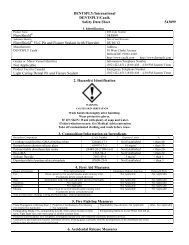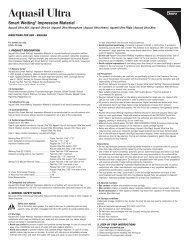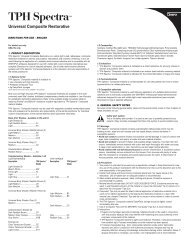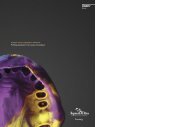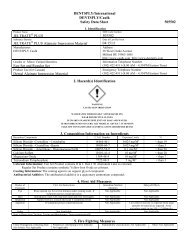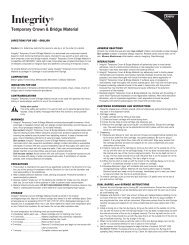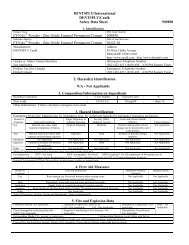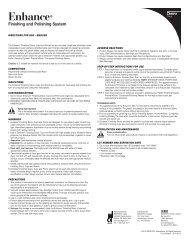Indirect and Direct Restorative Protocols - Caulk
Indirect and Direct Restorative Protocols - Caulk
Indirect and Direct Restorative Protocols - Caulk
You also want an ePaper? Increase the reach of your titles
YUMPU automatically turns print PDFs into web optimized ePapers that Google loves.
› “SmartCem2 is a valuable addition to my practice<br />
because of the effi ciency <strong>and</strong> time savings it affords me<br />
as well as my patient during the seating appointment.”<br />
Ronald A. Feinman, DMD<br />
Private practice, Atlanta, GA.<br />
Figure 3. A coat of the resin cement (ie, SmartCem2, DENTSPLY<br />
<strong>Caulk</strong>, Milford, DE) is applied to all surfaces that will contact the prepared<br />
tooth to eliminate any voids that may occur during the seating of<br />
the restoration (Courtesy: R.A. Feinman, Atlanta, GA).<br />
Figure 4. A tack cure of the cement can often allow the clinician to<br />
remove gross excess prior to fi nal curing of the luting cement without<br />
dislodging the restoration. Interproximal fl ossing can complete removal<br />
of excess cement prior to fi nal curing.<br />
› Recommendations<br />
for Cement Selection<br />
<strong>and</strong> Application<br />
■ The resin cement <strong>and</strong><br />
adhesive should have<br />
compatible activation<br />
mechanisms (eg, dualcured<br />
resin with<br />
dual-cured adhesive);<br />
■ Conventional resin<br />
cements are often indicated<br />
for less-retentive<br />
tooth preparations;<br />
■ Postoperative sensitivity<br />
can be minimized<br />
through agents such<br />
as Calm-It Desensitizer<br />
(DENTSPLY <strong>Caulk</strong>,<br />
Milford, DE); <strong>and</strong><br />
■ The radiopacity of the<br />
cement should enable<br />
subsequesnt evaluation<br />
for marginal decay.<br />
can opt for Prime & Bond® NT or XP<br />
BOND (DENTSPLY <strong>Caulk</strong>, Milford, DE)<br />
prior to light curing <strong>and</strong> application of<br />
the resin cement. Each of these materials<br />
provides versatility for use in light- <strong>and</strong><br />
dual-cured indications <strong>and</strong> favorable<br />
bond strengths that surpass those of similar<br />
etch-<strong>and</strong>-rinse adhesives. For a less<br />
technique-sensitive adhesive procedure,<br />
a self-etching system such as Xeno® IV<br />
(DENTSPLY <strong>Caulk</strong>, Milford, DE) may be<br />
employed to facilitate bonding.<br />
A resin-based, self-adhesive cement<br />
such as SmartCem2 (DENTSPLY<br />
<strong>Caulk</strong>, Milford, DE) might also be<br />
selected for its high strength <strong>and</strong><br />
convenience. Bonding is generally unnecessary<br />
with self-adhesive cements.<br />
This cement can be dispensed either<br />
via automix syringe or automix digit<br />
targeted delivery system according to<br />
the clinician’s preference; SmartCem2<br />
eliminates the time <strong>and</strong> inconveniences<br />
often associated with mixing or capsule<br />
activation. Its excellent retentive <strong>and</strong> mechanical<br />
strengths to dentin <strong>and</strong> enamel<br />
ensure that the cement bonds effectively<br />
to porcelain, composite, <strong>and</strong> metal<br />
restorations, <strong>and</strong> that SmartCem2<br />
effectively seals margins.<br />
Once SmartCem2 is applied to the<br />
restoration <strong>and</strong> placed on the prepared<br />
tooth (Figure 3), the restoration may be<br />
gently manipulated into place for optimal<br />
seating. The “gel phase” of SmartCem2<br />
(DENTSPLY <strong>Caulk</strong>, Milford, DE) starts<br />
approximately one to two minutes thereafter<br />
<strong>and</strong> lasts about one additional<br />
minute—providing the clinician with a<br />
favorable working time chairside. A tack<br />
cure of less than 10 seconds can also be<br />
used to initiate the gel phase. A scalpel<br />
<strong>and</strong> floss can then be used to remove any<br />
excess cement material (Figure 4). When<br />
the final curing has been completed, the<br />
indirect restoration can be smoothed<br />
lightly with a carbide finishing bur<br />
(eg, Midwest® Esthetic Finishing Bur,<br />
DENTSPLY Professional, York, PA) <strong>and</strong><br />
then polished to the desired appearance,<br />
with the clinician taking care to ensure<br />
its final luster <strong>and</strong> finish. ■<br />
22



